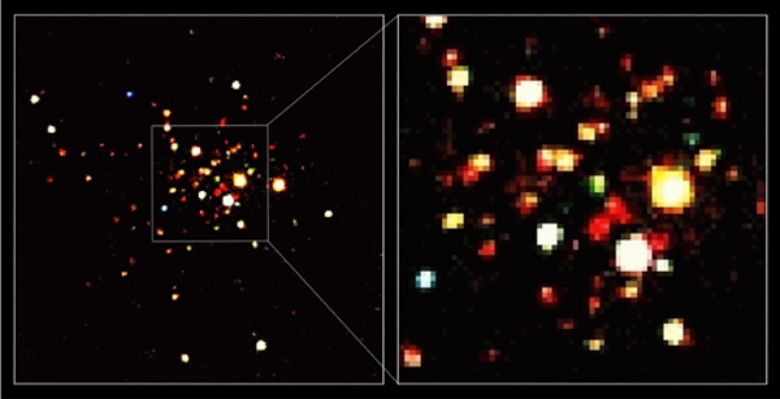
 Credit: NASA/CfA/J.Grindlay et al.
Credit: NASA/CfA/J.Grindlay et al.
Swarm of Stars
Globular clusters are spherical distributions of hundreds of thousands of
stars; these clusters are found on the outskirts of galaxies and form a
"halo" around the Galactic center. Because large numbers of stars are
packed into a relatively small region of space, stellar densities are
large. The stars in globulars have ages of billions of years and thus are
some of the oldest objects in the Galaxy (and maybe the Universe). Studies
of stars in globular clusters provide evidence for astronomers on important
topics such as stellar evolution and the age of the
universe. TheChandra X-ray
observatory has recently obtained the best X-ray image of a globular
cluster. The Chandra image (of the globular cluster, 47 Tucanae) is shown
above. Chandra finds more than 100 bright X-ray sources; nearly all these
sources are binary systems in which a collapsed star (a neutron
star or white
dwarf) pulls matter off a sun-like companion star; X-rays are emitted
by the matter as it gets heated to enormous temperatures (of millions of
degrees) as it crashes onto the surface of the compact object. The image on
the right show a zoomed image of the center of the cluster; the colors
represent the energy of the X-rays emitted by the stars (red-low energy,
blue-high energy). By understanding how these binary systems form
astronomers gain a deeper understanding about the interaction of stars in
this stellar swarm.
Last Week *
HEA Dictionary * Archive
* Search HEAPOW
* Education
Each week the HEASARC
brings you new, exciting and beautiful images from X-ray and Gamma ray
astronomy. Check back each week and be sure to check out the HEAPOW archive!
Page Author: Dr. Michael F.
Corcoran
Last modified June 2, 2001


